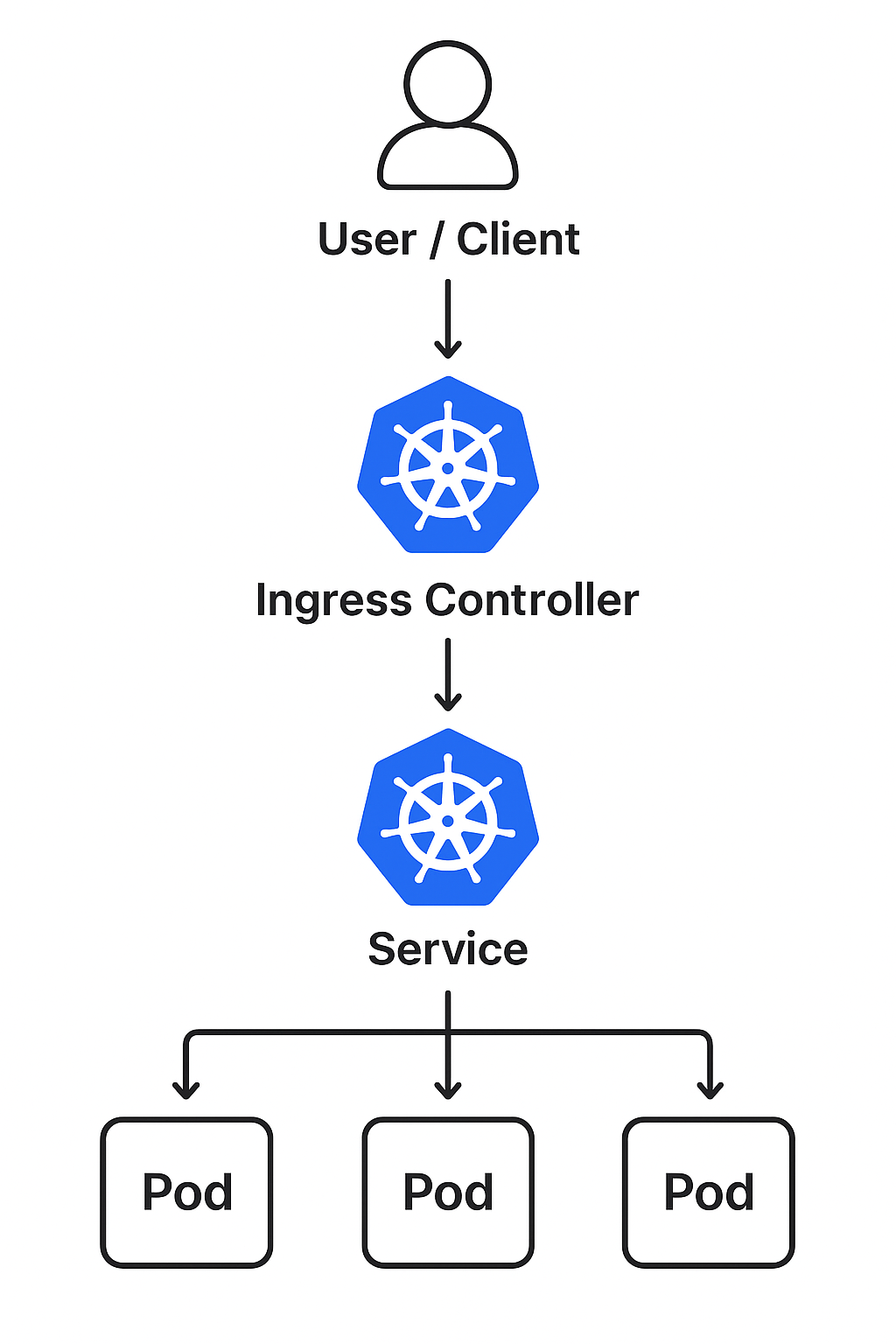Kubernetes Ingress
What is Ingress?
- Collection of rules that manage inbound connections to cluster Services
- Decouples routing rules from applications
- Centralizes rules management

Problem Solved
- Services have routing rules tied to them
- Many rules because many Services
- Need to update application without worrying about external access
Ingress Features
- TLS (Transport Layer Security)
- Name-based virtual hosting
- Fanout routing
- Load balancing
- Custom rules
How it Works
- Users connect to Ingress endpoint (not directly to Service)
- Ingress forwards request to desired Service
- Configures Layer 7 HTTP/HTTPS load balancer
Example Use Case
blue.example.com→ forwards towebserver-blue-svcgreen.example.com→ forwards towebserver-green-svc- Both go through same Ingress endpoint
Ingress Types
Name-Based Virtual Hosting
- Different hostnames route to different services
- Same Ingress endpoint handles multiple domains
Fanout Routing
- Different paths on same host route to different services
example.com/blue→webserver-blue-svcexample.com/green→webserver-green-svc
Key Concept
- Ingress resource - Only defines routing rules
- Ingress Controller - Does actual request forwarding
- Controller role - Reverse proxy that implements the rules
Ingress Controller
- Application that watches API server for Ingress resource changes
- Updates Layer 7 Load Balancer accordingly
- Also known as: Controllers, Ingress Proxy, Service Proxy, Reverse Proxy
Common Ingress Controllers
- GCE L7 Load Balancer Controller
- AWS Load Balancer Controller
- Nginx Ingress Controller
- Contour
- HAProxy Ingress
- Istio Ingress
- Kong
- Traefik
Configuration Requirements
- Must specify
ingressClassNamein Ingress resource - Example:
spec.ingressClassName: nginx - May need controller-specific annotations for advanced features
Minikube Setup
minikube addons enable ingress
Practical Examples
Basic Name-Based Virtual Hosting
apiVersion: networking.k8s.io/v1
kind: Ingress
metadata:
name: virtual-host-ingress
annotations:
nginx.ingress.kubernetes.io/rewrite-target: /
spec:
ingressClassName: nginx
rules:
- host: blue.example.com
http:
paths:
- path: /
pathType: Prefix
backend:
service:
name: webserver-blue-svc
port:
number: 80
- host: green.example.com
http:
paths:
- path: /
pathType: Prefix
backend:
service:
name: webserver-green-svc
port:
number: 80
Fanout Routing Example
apiVersion: networking.k8s.io/v1
kind: Ingress
metadata:
name: fanout-ingress
annotations:
nginx.ingress.kubernetes.io/rewrite-target: /
spec:
ingressClassName: nginx
rules:
- host: example.com
http:
paths:
- path: /blue
pathType: Prefix
backend:
service:
name: webserver-blue-svc
port:
number: 80
- path: /green
pathType: Prefix
backend:
service:
name: webserver-green-svc
port:
number: 80
TLS/HTTPS Ingress
apiVersion: networking.k8s.io/v1
kind: Ingress
metadata:
name: tls-ingress
spec:
ingressClassName: nginx
tls:
- hosts:
- secure.example.com
secretName: tls-secret
rules:
- host: secure.example.com
http:
paths:
- path: /
pathType: Prefix
backend:
service:
name: web-service
port:
number: 80
Common Commands
Deploy Ingress Resource
# Create Ingress from file
kubectl create -f virtual-host-ingress.yaml
kubectl apply -f virtual-host-ingress.yaml
View Ingress Resources
# List all Ingress resources
kubectl get ingress
kubectl get ing
# Detailed view
kubectl get ingress -o wide
kubectl describe ingress virtual-host-ingress
Access Services Using Ingress
- Access services using configured URLs
- Example:
blue.example.comandgreen.example.com
Local Testing Setup (Minikube)
# Get Minikube IP
minikube ip
# Edit hosts file
sudo vim /etc/hosts
# Add entries (replace with your Minikube IP)
192.168.99.100 blue.example.com green.example.com
Troubleshooting Commands
# Check Ingress Controller pods
kubectl get pods -n ingress-nginx
# Check Ingress Controller logs
kubectl logs -n ingress-nginx deployment/ingress-nginx-controller
# Test connectivity
curl -H "Host: blue.example.com" http://MINIKUBE_IP